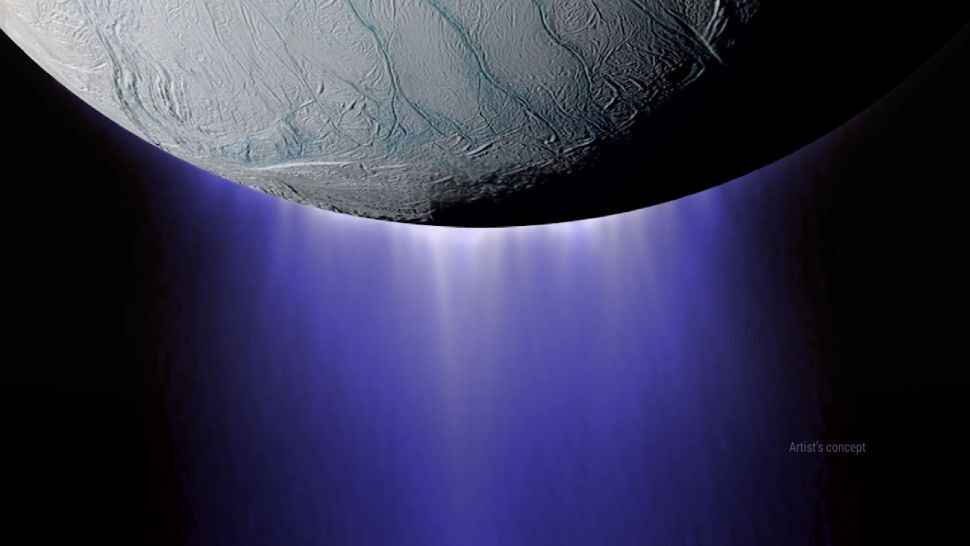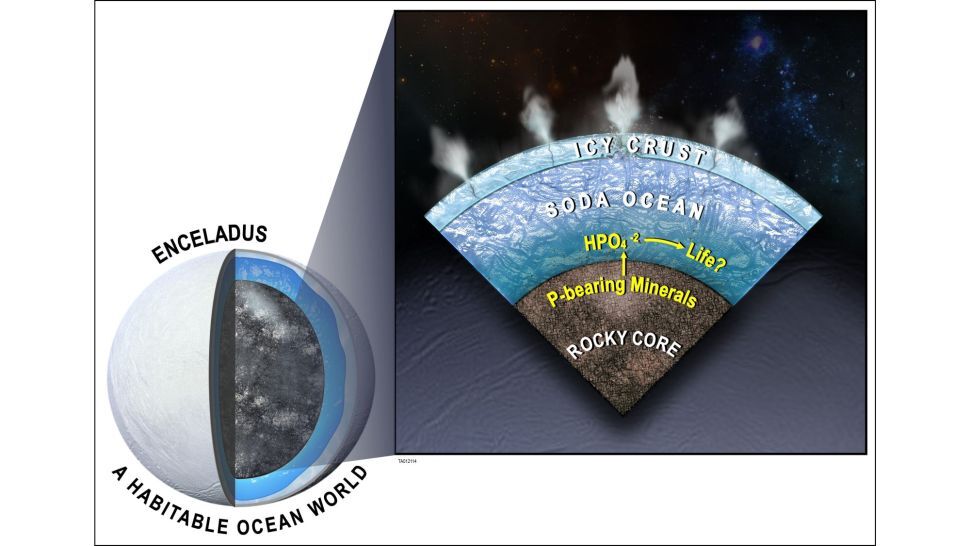3.10.2022
The chances of life on Enceladus have just risen thanks to a new understanding of the chemistry of the moon's ocean.

The ocean inside Saturn's moon Enceladus may be enriched with phosphorus, an important element for life as we know it, new research reveals.
Phosphorus is a vital component of life's biochemistry. For instance, it joins with sugars to provide a "backbone" to DNA, bonding the four nucleobases to the double helix. Phosphorus is also used in cell membranes and bones, as well as in a molecule called adenosine triphosphate, which carries metabolic energy around the body.
Yet previous studies had suggested that phosphorus would be rare on Enceladus. Scientists caught a glimpse of the ocean's makeup via the huge water geysers that spray out through "tiger stripes," deep vents in the moon's icy surface. On numerous occasions prior to its mission ending in 2017, NASA's Cassini spacecraft flew through and "tasted" these geysers, analyzing the chemical components. The spacecraft detected elements and molecules that are instrumental to life as we know it, including organic molecules such as methane, plus ammonia, carbon, nitrogen, oxygen and possibly hydrogen sulfide.
Yet the absence of phosphorus is notable. In 2018, research by Harvard's Manasvi Lingam and Avi Loeb concluded that phosphorus would be scarce in Enceladus' ocean because phosphorus in the rocks on the seabed would slowly dissolve into the ocean. On Earth, phosphorus is made available through the weathering of dry land, which Enceladus lacks.
However, a new study led by Jihua Hao, a senior research scientist at the University of Science and Technology of China, contradicts these earlier findings, claiming that the 2018 research used outdated geochemical models of Enceladus' rocky ocean floor.
"While the bio-essential element phosphorus has yet to be identified directly, our team discovered evidence for its availability in the ocean beneath the moon's icy crust," study co-author Christopher Glein, a senior research scientist at the Southwest Research Institute in San Antonio, said in a statement.
Using new modeling based on the latest available data, Hao and Glein's group simulated how phosphorus-rich minerals called phosphates dissolve into the ocean from Enceladus' rocky core. In particular, the team found that the dissolution rate of a mineral called orthophosphate would be much higher than what previous studies suggested, capable of filling the ocean with a concentration high enough to support life in just tens of thousands of years. One reason this high concentration is possible is the presence of bicarbonates in the ocean water, the chemical properties of which allow phosphates to accumulate in the ocean.

A cross section of Enceladus' interior showing how phosphorus-bearing minerals can dissolve into orthophosphate that can then enrich the ocean but potentially be gushed into space by the geysers. (Image credit: SwRI)
"The underlying geochemistry has an elegant simplicity that makes the presence of dissolved phosphorus inevitable, reaching levels close to, or even higher than, those in modern seawater [on Earth]," Glein said. "What this means for astrobiology is that we can be more confident than before that the ocean of Enceladus is habitable."
Despite the tantalizing possibilities, the findings represent a hypothesis; to prove that Enceladus' ocean contains phosphorus, a future mission to Enceladus would have to directly detect orthophosphate or some other phosphorus-derived mineral in the water geysers that regularly erupt from the moon.
"We need to get back to Enceladus to see if a habitable ocean is actually inhabited," Glein said.
The findings were published Sept. 19 in the journal Proceedings of the National Academy of Sciences.
Quelle: SC
